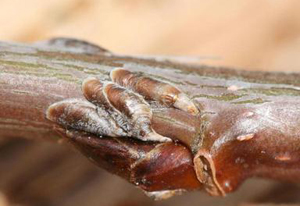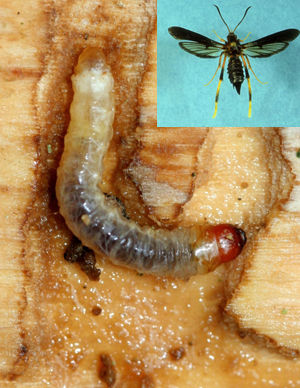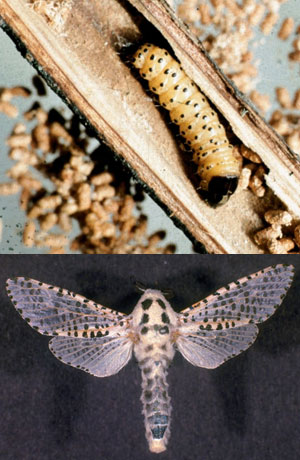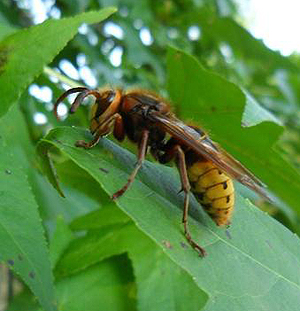Leaf Feeders

Alton N. Sparks, Jr., University of Georgia, Bugwood.org
Thrips are very small, elongate insects that feed by puncturing the outer skin of the leaf and sucking out the fleshy leaf tissue. Their feeding causes off-colored foliage and stunted growth.
Sap Feeders

Whitney Cranshaw, Colorado State University, Bugwood.org
Oystershell scales are about 1/10 inch long and resemble crusty accumulations of oyster shells on the bark. Their drab, bark-like appearance makes them easy to overlook, even on close inspection. Heavy infestations can kill twigs or branches. This scale overwinters in the egg stage under the waxy covering of the female. The eggs hatch and the crawlers are active from late May to early June.
Borers

larva: David Cappaert, Bugwood.org;
adult (inset): James Solomon, USDA Forest Service, Bugwood.org
Lilac borers are the caterpillar stage of a wasp-like moth that lays its eggs by wounds or roughened areas on the bark in August and September. The larvae tunnel under the bark and spend the winter there. They resume development in the spring. The larvae tunnel into the bark but maintain an opening where they expel their sawdust-like waste. The wound can be an entryway for a wood-destroying fungus. There is one generation per year.

Petr Kapitola, Central Institute for Supervising and Testing in Agriculture,
Bugwood.org (larva);James Solomon, USDA Forest Service, Bugwood.org (adult)
Both the caterpillar and adult of the Wood leopard moth are very distinctive. The caterpillar is the damaging stage, feeding under the bark of host trees. It is a white-orange color with numerous spots on its body. The adult is white with six black dots on the thorax and black markings on the remainder of the body. Adults may be active June-September and larvae feed inside of plants for 2-3 years.
Bark Feeders

David Stephens, Bugwood.org
European hornets may girdle lilac stems as they chew off bark. The appearance resembles gnawing by rodents but the wood is smooth with no tooth marks.